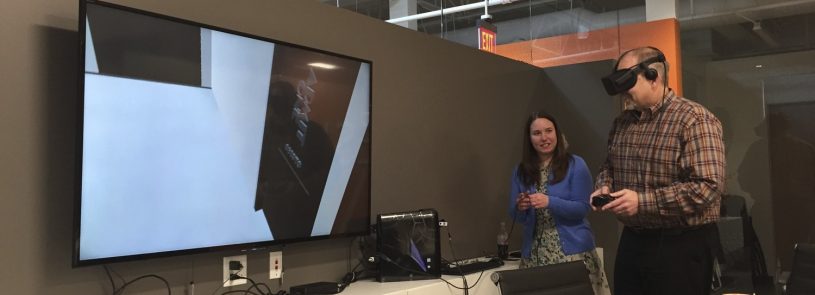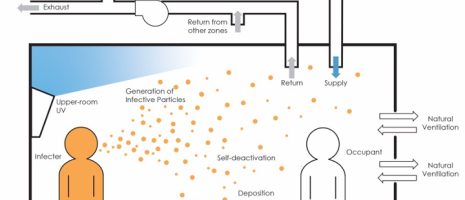3-D and VR walkthroughs: Experiencing how a design works is key for processes

IMEG’s Sarah Garthaus guides a client through a virtual reality walkthrough at Legat Architects’ office in Gurnee, Ill. Learn more.
By Sarah Garthaus
While virtual reality and 3-D walkthroughs show how architects have designed spaces to look, walkthroughs of process-based facilities show how engineers have designed spaces to work. This is key for owners of industrial and automotive plants, research facilities, and hospitals, where the design and placement of equipment is paramount to the processes carried out within these buildings.
Like all projects, the design begins by understanding the owner’s needs and gathering input from end users. Enabling clients to then experience the design in the early stage is the best way to ensure they understand what they’re getting and that they’re getting what they want – especially for those who have little or no experience deciphering 2-D drawings, like stakeholders. So a 3-D or virtual reality walkthrough gives a very clear understanding of the design they are about to receive – and the opportunity to ask for changes early in the design process.
Our walkthroughs begin with our building information model for a project, which includes additions to the standard Revit Structure and MEP content. The resulting data-rich 3D model, which integrates all engineering design disciplines, is also processed for lighting and material qualities. Using rendering plug-ins, we then use a gaming engine to add interactivity that, like a video game, allows viewers to control their movement through the model, inside and out. We can send the downloadable file to the client, who can explore the project via a computer monitor (no special software required) and using a keyboard or controller to direct their walkthrough.
For an immersive, virtual reality experience, we can also bring an Oculus Rift headset to the client; those not wearing the goggles can watch the user’s walkthrough via a monitor, allowing the entire group to be involved in the discussion of what is being seen. Everyone is usually a little shy about putting on the headset at first, but once they ‘step in’ they’re amazed. They quickly learn how to move around the space – they usually bump into a few walls, but that’s part of the fun.
Any view and number of systems can be shown; items can be turned on or off, and colors added. As the users “walk” around – navigating hallways, stairs, rooms, mechanical spaces, etc., moving their head to look left, right, up, down, or over or under any item – they begin to understand the design, and notice any areas that may be of concern. Should design changes be required, they can be made early, reducing errors and miscommunication in the construction phase and saving owners time and money.
Clients can even benefit before they see the walkthrough, as we use the software to see, in real time, the effect of moving something in Revit. If a conflict comes up during construction, we can send a walkthrough to the contractor, eliminating the back-and-forth with 2-D sketches or having to send an engineer to the site.
Several of our clients have already benefited from our VR and 3-D walkthroughs, which we can provide at a fraction of the cost of physical mockups. As the technology rapidly evolves, enhancements and ever-improving efficiencies will continue to provide additional value for owners and designers alike. I foresee walkthroughs that include acoustics, the use of Google Cardboard goggles to allow wide-range access and review of public projects and more interaction and animation.
3 ways to experience an IMEG 3-D walkthrough
Watch project videos:
- Recent renovation project narrated by IMEG’s Sarah Garthaus
- Two industrial projects
Using the Microsoft Edge browser: Navigate around a mechanical room using the arrow keys on your keyboard.
Download an executable file: Transfer this 3-D walkthrough file to your desktop, then run the file. Refer to this guide for system requirements and navigation instructions.
Hear Sarah Garthaus discuss (click links below to play):
- How VR models are created and presented to clients
- How clients react to being “virtually immersed”
- The benefits of a VR walkthrough












